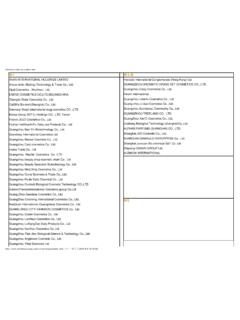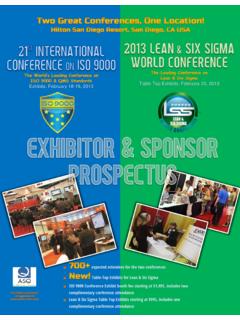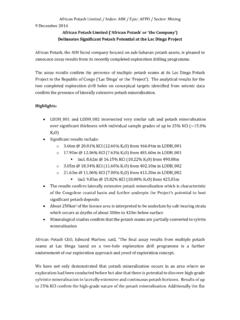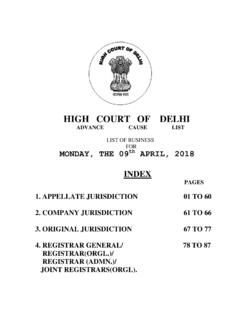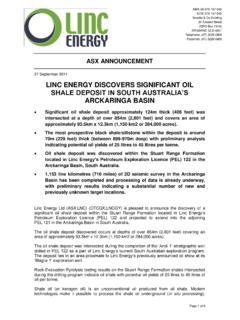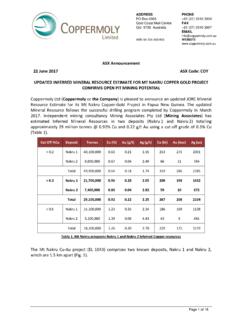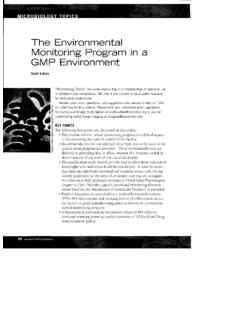Transcription of CONDITION - upisecke.za.net
1 SEPTEMBER 2017 LUBES N GREASES EUROPE-MIDDLE EAST-AFRICA22An Effective LabSampling method and record keeping are the most important parts of any investigation if a lab s conclu-sions are to be valid. Sampling must provide a representative sample for the analyst, and a sufficient set of samples is required for a statistically meaningful suite of conclusions to be drawn. Since most investigations are likely to be concerned with identifying potential contaminants, it is vital that contamination during sampling be minimized. In fluids and fine pow-ders testing, sample containers must be clean and their storage conditions controlled and documented. Sampling equipment should be flushed with the material at least three times, where practical. Sam-pling valves/pipes should be flushed of old product and debris, if this is not relevant to the investigation. As large a quantity of fluid as is practi-cal should be obtained to ensure that the sample is fully representative and, where possible, sample con-tainers should be filled to 80 to 90 percent of , the laboratory in-vestigation can proceed under the The oil analysis laboratory can play an important role in supporting root cause investigations.
2 However, the laboratory needs to be powerfully equipped, with both the best analytical instrumentation and fluid know-how if it is to be N GREASES EUROPE-MIDDLE EAST-AFRICA SEPTEMBER 201723BY ROBERT CHAPMANCONDITIONKEEPSHEALTHYEQUIPMENTSEP TEMBER 2017 LUBES N GREASES EUROPE-MIDDLE EAST-AFRICA24usual strict controls set out by the accredited laboratory quality system, including full traceability of sample custody and origin. The remainder of this article presents some use-ful technical information on some common tests and a two case studies, which, at a technical level, we are permitted to disclose and where expert laboratory support has been a key to root cause incident diagnosis or preventative case studies shown below illustrate the role that an expert laboratory can play. It also explores the innovative nature of an analysis laboratory in supporting industry and saving s MeasuredLubricant and fuel testing can be a critical first line of investiga-tion where tools traditionally used for oil CONDITION monitoring and fuel quality certification can play a critical role.
3 Depending on the circumstances, a suite of tests must be carefully deployed to provide the key diagnostic Analysis: A scanning electron microscope with energy dispersive X-ray fluorescence (SEM-EDXRF) can identify the constitu-ents of particles or particulates found in fluid particulate contamination can often provide critical root cause evidence of a failure. For metal particles, analyzing the morphology shape and size and their el-emental composition can determine the metal alloy type, and this can SEM image of wear particles isolated from used image of wear particle isolated from used MARKETER OF SPECIALITY OILS & FLUIDSWE START BY UNDERSTANDING YOUR PROBLEMSIP is an independent marketer of speciality oils and fluids. We reliably deliver specified product solutions backed by wide-ranging technical and industry uses its extensive application knowledge to specify, develop & supply speciality oils and fluids. We supply a wide variety of customers from niche formulators to multinational corporations in over 30 s comprehensive range of speciality base oils and fluids are used in a variety of applications including: Offshore exploration drilling fluids Pharmaceuticals and personal care products Premium industrial lubricants White process oils Automotive lubricants To see how we could help your business call 0044 (0)20 7717 0100 or visit Ltd, Westminster Tower, 3 Albert Embankment, London SE1 7SP, United KingdomSIP5043_Lubes+ 115/12/11 15:52:59 LUBES N GREASES EUROPE-MIDDLE EAST-AFRICA SEPTEMBER 201725 Wear debris from wind turbine oil image of wear debris in wind turbine oil in the WindIntertek s OCM diagnostician team identified a sudden increase in wear metal (Iron) and PQ (Ferrous) index results in a sample taken from a wind turbine gearbox.
4 We performed a full debris investigation using Scanning Electron Microscopy with Energy Dispersive X-Ray. The results indicated that the metal was a low alloy bearing steel. We recommended that the gearbox be inspected to check for bearing or raceway customer investigated and confirmed the analysis, finding a damaged bearing race and housing in the gearbox. Cost savings, taking into account the replaced parts and downtime saved, was estimated to be more than $75, < < < < < < < < < < < < < Oil Analysis ICP (ppm)Sometimes chemistry has nothing to do with like to say we use superior science to find unique solutions to solve manufacturing concerns. But at the end of the day, our business is really a people business. People talking, people building trust, people solving problems. Together. At the end of the day, the difference is chemistry. The human kind. 2017 The Elco CorporationWant to hear more about how we work? Visit us at DIFFERENCEIS CHEMISTRY. SEPTEMBER 2017 LUBES N GREASES EUROPE-MIDDLE EAST-AFRICA26identify the system or component that is producing the material.
5 It is useful for identifying particulate and wear debris that have been generated by components in oil-wetted systems. Unusually high levels of particular alloy types can identify components suffering from excessive Analysis: Elemental analysis provides key information about a variety of parameters, all of which are useful to the investigator. It gives a quantitative measurement of wear metal levels in an oil sample down to concentrations as low as parts per million. Lube additive depletion levels and the presence of contamination by other fluids can also be assessed. At an experienced laboratory, data can be compared to the historic records of an individual system, allowing anomalies to be Dilution: Fuel dilution of crankcase lubricants may occur due to the build-up of fuel from an injec-tor problem, or because engine wear is allowing combustion chamber blow-by. It can significantly decrease oil viscosity and cause poor lubricant performance and, in extreme cases, crankcase explosions.
6 High levels of fuel dilution along with reduced oil viscosity can indicate piston ring wear, which may be a cause of poor engine performance and fuel Content: Water is a com-mon contaminant and can cause poor lubrication, icing, microbiologi-cal growth and corrosion, leading to accelerated and excessive wear, rusting or other performance Content: Soot content increases over time in engine oils, particularly if incomplete combus-tion occurs. The soot particles are too small to be removed by the oil filter and remain in suspension. Very high soot content can reduce oil vis-cosity and degrade oil Base Number (TBN): This test measures the level of basic (alkaline) constituents in an oil sample. Alkaline additives are pres-ent in certain oils to help prevent the build-up of acidic compounds as the oil degrades. Additive depletion oc-curs as the oil degrades and oxidizes; therefore, reduced TBN levels can be used to identify engines that are due for an oil change, or engines that may be suffering from poor combus-tion Acid Number (TAN): This test assesses the acidity level of an oil sample.
7 As oils degrade, acidic compounds form that can increase the measured TAN value. High TAN Continued on page 29 SponsorLUBES N GREASES EUROPE-MIDDLE EAST-AFRICA SEPTEMBER 201729 ACI European Base Oils and Lubricants interactive Summit ..38 Anderol BV ..33 BASF ..5 BRB International BV ..11 Calumet Specialty Products Partners ..12 Chevron ..27 Chevron Phillips Chemical ..20 Elco Corporation ..25 Eni ..43 Ergon International, Inc..INSIDE FRONT COVERE vonik Oil Additives ..9 ExxonMobil Basestocks ..7 ExxonMobil Chemical ..BACK COVERF luid Solutions ..18 ICIS African Base Oils & Lubricants Conference ..41 ICIS & ELGI Industrial Lubricants Conference ..28 IPAC ..17 King Industries ..32 Lubes n Greases Base Oil Pricing Data ..37 Lubricants Industry Factbook ..35 MOGoil ..8 Neste ..13 Nyco ..16S-Oil ..19 SIP Ltd..24 UEIL Annual Congress ..26 Viscolube ..21 Zschimmer & Schwarz, Inc. Lexolube Division ..39 COMPANY PAGEA dvertisers Indexillustrate the role that the expert laboratory can play in maintaining equipment reliability, supporting an industry and saving money.
8 ORobert Chapman is the Oil CONDITION Monitoring (OCM) Global Lead for intertek , over-seeing 21 locations globally. Based in the United King-dom, he has a background in Physics and provides technical and commercial leadership for the OCM laboratories within intertek . Contact him at intertek at oxidation and excessive oil Sizing: Hydrau-lic systems in particular require fluids that are superclean ; that is, free of dirt or particulates. Otherwise, excessive wear or blockages can occur. This technique measures the size and number of particles present in a fluid. They are then grouped into counts of particles within particular size ranges, and an overall rating is as-signed that illustrates fluid The examples cited here Keeping a Ship SailingIntertek s oil CONDITION monitor-ing diagnostics team identified a sudden increase in wear metal (iron) and Particle Quantification index in an oil sample taken from a ship s thrust block. PQ index is a measure of total ferrous particles present in the sample.
9 A full debris investigation was performed, using scanning electron micros-copy with energy dispersive X-ray spectroscopy (SEM-EDX).The results indicated that the metal present was a type of carbon manganese steel, but a smaller amount of chromium low alloy steel also was present. An inspection of the thrust block revealed bearing housing and raceway damage. The vessel was successfully repaired, and it returned to service after sea trials. The cost savings, taking into account the replaced parts and downtime saved, was estimated to be more than $250, image of wear debris in ship s oil from page 26
